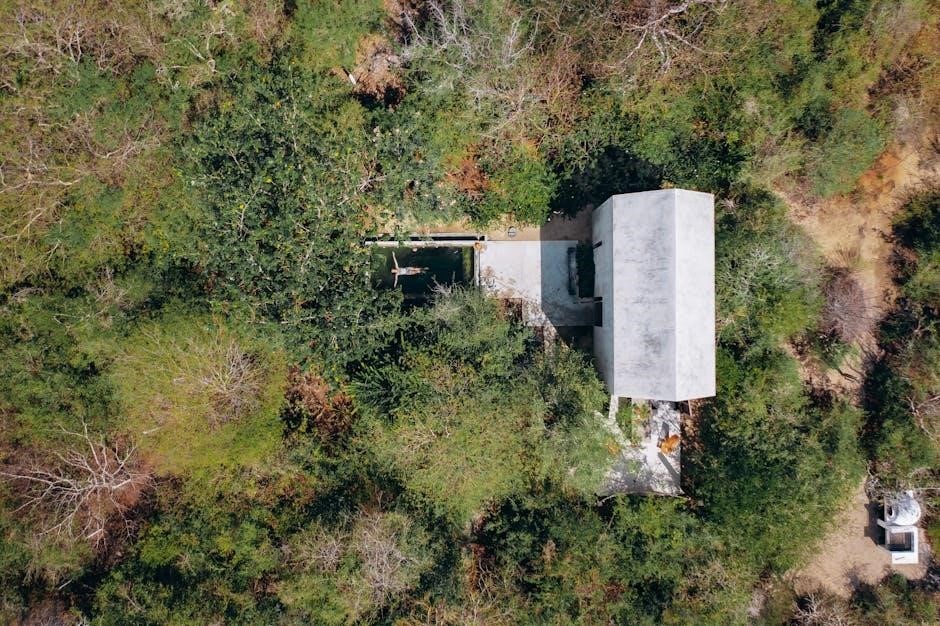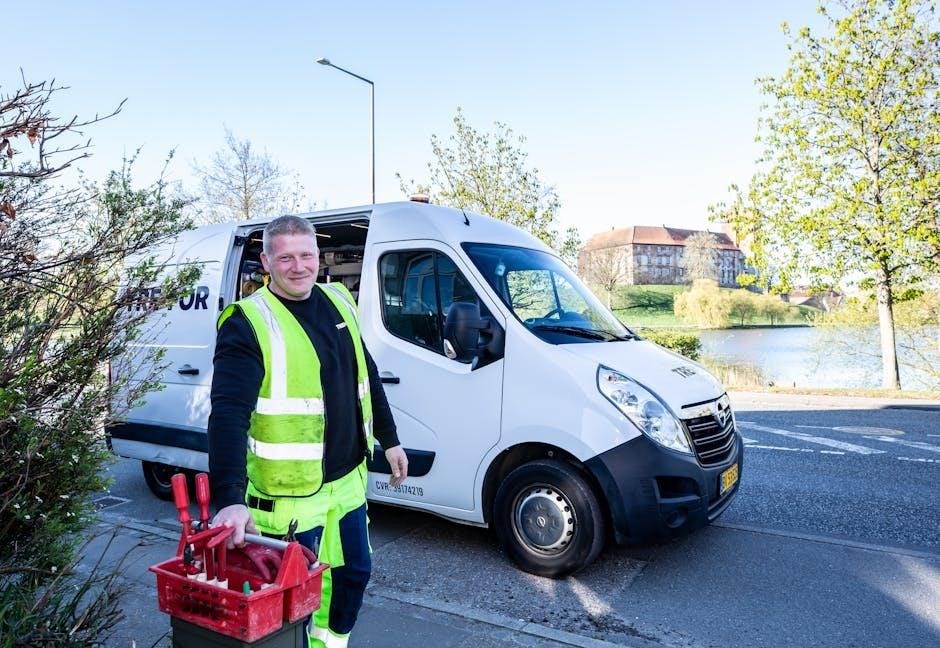A Private Road Maintenance Agreement (PRMA) is a legally binding document outlining the responsibilities and costs for maintaining private roads, ensuring safety and access for all users.
1.1. Definition and Purpose
A Private Road Maintenance Agreement (PRMA) is a legally binding document that outlines the responsibilities and obligations of property owners or entities involved in maintaining a private road. Its primary purpose is to ensure the road remains safe, accessible, and well-maintained for all users. This agreement is essential for properties with shared access, as it prevents disputes and clarifies financial and operational responsibilities, ensuring long-term sustainability and compliance with local regulations.
1.2. Importance of a Written Agreement
A written Private Road Maintenance Agreement is crucial for preventing disputes and ensuring clarity among property owners. It establishes clear responsibilities, financial obligations, and maintenance standards, reducing conflicts and legal issues. A formal agreement also provides accountability, ensuring all parties contribute fairly to upkeep. Without it, disagreements over costs or responsibilities can arise, leading to neglect of the road and potential safety hazards. A written agreement safeguards everyone’s interests and ensures long-term road viability.

Key Components of a Private Road Maintenance Agreement
A private road maintenance agreement outlines the scope of work, financial responsibilities, and dispute resolution processes, ensuring clarity and mutual understanding among all parties involved.
2.1. Parties Involved
The parties involved in a private road maintenance agreement typically include property owners, contractors, and sometimes local governments. These individuals or entities share responsibility for maintaining the road. Property owners often contribute financially or through labor, while contractors handle the physical work. Local governments may oversee compliance or provide guidelines. The agreement must clearly define each party’s role to ensure accountability and fairness. Successors and assigns are also bound by the agreement, ensuring long-term maintenance commitments.
2.2. Scope of Maintenance
The scope of maintenance in a private road agreement typically includes activities like grading, paving, restoring gravel bases, and cleaning drainage systems. It may also involve snow removal and ensuring sight distances meet local standards. The agreement outlines the specific tasks and frequency of maintenance to keep the road safe and accessible. Regular inspections and repairs are often required to prevent deterioration. This ensures the road remains in good condition for all users, including emergency vehicles, and upholds property values.
2.3. Financial Responsibilities
Financial responsibilities in a private road maintenance agreement are typically shared among property owners, proportional to their use or ownership of the road. Costs may include materials, labor, and equipment for repairs, snow removal, and improvements. The agreement often specifies payment methods, such as annual fees or special assessments. It may also address tax implications, ensuring all parties understand their contribution to maintaining the road’s condition and accessibility for everyone involved.
2.4. Dispute Resolution
Dispute resolution clauses in private road maintenance agreements ensure conflicts are addressed efficiently. Mediation or arbitration may be required before litigation, involving neutral third parties to resolve issues. The agreement often outlines steps for resolving disputes, such as notifying all parties in writing and establishing a timeline for resolution. This helps maintain harmony and avoids costly legal battles, ensuring the road remains well-maintained and accessible for all users.
Legal Requirements for Private Road Agreements
Legal requirements for private road agreements include proper signatures, notarization, compliance with local laws, and registration with relevant authorities to ensure enforceability and clarity for all parties involved.
3.1. Signatures and Notarization
Signatures from all parties involved are essential to validate a private road maintenance agreement. Notarization ensures the authenticity of these signatures, making the agreement legally binding. Witnesses may also be required in some jurisdictions to confirm the voluntary nature of the signatories’ consent. Failure to secure proper signatures or notarization can render the agreement unenforceable in court. Therefore, this step is critical to establish a formal and recognizable contractual obligation among property owners and maintainers of the private road.
3.2. Compliance with Local Laws
Ensuring compliance with local laws is crucial when drafting a private road maintenance agreement. This includes adhering to zoning regulations, environmental standards, and safety codes. Failure to comply can lead to legal disputes or even the agreement being deemed invalid. It is essential to consult local ordinances and seek legal advice to ensure all terms align with current legislation. Compliance not only avoids legal issues but also ensures the agreement is enforceable and meets community standards for road maintenance and safety.
3.3. Registration with Local Authorities
Registering a private road maintenance agreement with local authorities is a critical step to ensure its enforceability. This process involves submitting the finalized document to the appropriate county or municipal office. Registration provides a public record of the agreement, making it easily accessible for future reference. It also verifies compliance with local regulations and ensures that all parties are legally bound by the terms. Proper registration safeguards the interests of all involved and prevents potential disputes over the agreement’s validity.

Benefits of a Private Road Maintenance Agreement
A private road maintenance agreement ensures safe and accessible roads, distributes costs fairly among users, and prevents disputes by establishing clear responsibilities and expectations for all parties involved.
4.1. Prevents Disputes Among Property Owners
A private road maintenance agreement clearly outlines responsibilities and costs, reducing conflicts among property owners. By defining maintenance tasks, payment structures, and dispute resolution processes, it ensures fairness and transparency, minimizing potential disagreements over road upkeep and access rights. This formal agreement acts as a reference point, helping to resolve issues amicably and maintain harmonious relationships among all parties involved in the shared private road.
4.2. Ensures Safe and Accessible Roads
A private road maintenance agreement ensures roads remain safe and accessible by outlining specific maintenance tasks, such as snow removal, drainage upkeep, and surface repairs. Regular maintenance prevents deterioration and hazards, ensuring reliable access for residents and emergency vehicles. This agreement promotes adherence to safety standards, reducing risks and liabilities for all parties involved. By addressing maintenance proactively, it guarantees that the road remains functional and secure for everyone who relies on it.
4.3. Distributes Costs Fairly
A private road maintenance agreement ensures that costs are distributed fairly among property owners, preventing financial burdens on individuals. By establishing a proportional sharing system based on usage or property value, it promotes equity and transparency. This approach fosters cooperation and reduces conflicts, as all parties contribute according to their benefit from the road. Fair cost distribution is essential for maintaining harmony and ensuring the road’s upkeep without overburdening any single owner.
Steps to Create a Private Road Maintenance Agreement
Creating a private road maintenance agreement involves drafting the document, reviewing terms, negotiating with parties, finalizing the agreement, and ensuring legal compliance and registration.
5.1. Drafting the Agreement
Drafting a private road maintenance agreement involves outlining the scope of work, responsibilities, and financial terms. It should include details about the parties involved, maintenance tasks, and payment structures. Using templates can simplify the process, ensuring all legal and practical aspects are covered. The agreement should be clear, concise, and legally binding to avoid future disputes. Legal review is recommended to ensure compliance with local laws and regulations.
5.2. Reviewing and Negotiating Terms
Reviewing and negotiating terms ensures all parties understand their obligations and agree to the conditions. This step involves discussing maintenance responsibilities, cost-sharing, and dispute resolution. Legal counsel often participates to verify compliance with local laws. Negotiations may address specific concerns, such as proportional cost distribution or future amendments. Reaching a consensus is crucial for a fair and enforceable agreement, ensuring all parties are satisfied with the final terms before signing.
5;3. Signing and Executing the Agreement
Once all terms are agreed upon, the agreement must be signed by all parties involved. Ensure signatures are notarized to validate the document legally. Witnesses may also be required, depending on local laws. The agreement becomes enforceable upon signing, binding all parties to its terms. Proper execution ensures clarity and mutual understanding, preventing future disputes. Non-compliance with execution requirements can render the agreement invalid, so attention to detail is crucial at this stage.
5.4. Registering the Agreement
After signing, the agreement must be registered with local authorities to ensure compliance and public record. Submit the document to the county clerk or recorder’s office, following specific filing requirements. Registration provides transparency and protects the interests of all parties involved. It also ensures that future owners or stakeholders are aware of their obligations. Proper registration can prevent disputes and validate the agreement’s enforceability under local laws and regulations. Timely filing is essential to avoid legal complications.
Common Mistakes to Avoid
Common errors include omitting clear maintenance terms, neglecting legal reviews, and failing to address future changes or dispute resolution, which can lead to costly conflicts and confusion.
6.1. Vague Terms and Conditions
Vague terms in a private road maintenance agreement can lead to disputes and misunderstandings. For example, terms like “periodic maintenance” or “shared costs” lack specificity, causing confusion. Without clear definitions, parties may interpret responsibilities differently. It is essential to outline exact duties, such as who handles snow removal or repairs, and how costs are calculated. Ambiguity can result in delayed repairs, financial disagreements, or even legal conflicts, emphasizing the need for precise language to ensure clarity and mutual understanding among all parties involved.
6.2. Lack of Legal Review
Failing to have a private road maintenance agreement legally reviewed can lead to enforceability issues and potential disputes. Without legal oversight, the document may omit critical clauses or violate local regulations. Attorney review ensures compliance with laws and protects all parties’ interests. Overlooking this step can result in unenforceable terms, leading to financial or operational disputes. Legal expertise helps identify and address potential loopholes, ensuring the agreement is robust and binding for all involved.
6.3. Not Accounting for Future Changes
Omitting provisions for future changes in a private road maintenance agreement can create challenges as circumstances evolve. Property ownership, road usage, and maintenance needs may change, requiring adaptable terms. Without flexibility, the agreement may become outdated or ineffective. Including clauses for amendments, dispute resolution, and cost adjustments ensures the agreement remains relevant and functional over time, accommodating new developments and maintaining harmony among stakeholders. Regular reviews and updates are essential to reflect changing conditions and priorities.

Case Studies of Successful Agreements
Case studies highlight successful private road maintenance agreements, demonstrating how cooperation and clear terms ensure safe and well-maintained roads, benefiting all property owners involved equally.
7.1. Examples from Different Regions
Examples from Midland County and North Carolina demonstrate effective private road maintenance agreements. Midland County’s agreements ensure regular maintenance and safety, while North Carolina’s template provides clarity and fairness. Similarly, ASEAN countries have adopted structured agreements to manage shared road responsibilities. These regional examples highlight the importance of tailored solutions, ensuring proportional cost-sharing and clear dispute resolution mechanisms. They serve as models for drafting agreements that balance local needs with legal requirements, fostering cooperation among property owners and maintaining safe, accessible roads for all users.
7.2. Lessons Learned from Failed Agreements
Failed private road maintenance agreements often result from vague terms, insufficient legal oversight, and poor cost-sharing mechanisms. For instance, agreements lacking clear dispute resolution processes can lead to unresolved conflicts. Additionally, failure to account for future changes, such as new property owners or environmental factors, can render agreements obsolete. Lessons from such cases emphasize the importance of detailed planning, legal review, and adaptability to ensure long-term functionality and fairness for all parties involved in maintaining private roads.
The Role of Local Governments
Local governments play a crucial role in overseeing private road maintenance agreements, ensuring safety, accessibility, and compliance with community standards and regulations effectively.
8.1. Providing Guidelines and Templates
Local governments often provide standardized templates and guidelines for drafting private road maintenance agreements. These resources ensure compliance with legal requirements and include provisions for maintenance responsibilities, cost-sharing, and dispute resolution. Templates may cover specifics like road improvements, snow removal, and drainage upkeep, helping property owners create clear, legally binding agreements tailored to their needs while adhering to community standards.
8.2. Overseeing Compliance
Local governments play a crucial role in ensuring adherence to private road maintenance agreements. They review agreements for compliance with local ordinances, conduct periodic inspections, and monitor adherence to maintenance standards. Non-compliance may result in enforcement actions, such as fines or mandated repairs. This oversight ensures that private roads remain safe and accessible, aligning with community standards and legal requirements. Regular audits and reporting mechanisms help maintain accountability among property owners and stakeholders involved in road upkeep.
8.3. Offering Incentives for Proper Maintenance
Local governments often provide incentives to encourage property owners to maintain private roads properly. These incentives may include tax reductions, grants, or expedited permitting for compliant landowners. Some jurisdictions offer reimbursement programs for maintenance costs or prioritize funding for communities with active agreements. Such measures encourage adherence to maintenance standards, fostering safer and more accessible roads while reducing the financial burden on residents. These incentives align with broader public safety and infrastructure goals, promoting a collaborative approach to road upkeep.
The Future of Private Road Maintenance
The future of private road maintenance lies in technology integration and sustainable practices, ensuring efficient, eco-friendly solutions for modern infrastructure needs.
9.1. Emerging Trends in Road Maintenance
Emerging trends in road maintenance include the use of predictive maintenance technologies, such as IoT sensors and AI, to identify issues before they escalate. There is also a growing emphasis on sustainable practices, like using recycled materials and green infrastructure. Additionally, digital platforms for drafting and managing private road maintenance agreements are becoming more popular, streamlining communication and cost-sharing among property owners. These innovations aim to enhance efficiency, reduce costs, and promote environmentally friendly solutions for private road upkeep.
9.2. Impact of New Technologies
New technologies are revolutionizing private road maintenance by enhancing efficiency and transparency. AI-driven predictive maintenance systems optimize repair schedules, while IoT sensors monitor road conditions in real-time. Digital platforms streamline agreement drafting and cost-sharing, ensuring all parties are aligned. Advanced data analytics enable better decision-making, reducing long-term costs. Additionally, blockchain technology can secure agreements, and digital signatures simplify execution. These innovations not only improve road quality but also foster collaboration among property owners, making private road maintenance more accessible and sustainable.
9.3. Increasing Environmental Considerations
Modern private road maintenance agreements increasingly prioritize environmental sustainability. Practices like using permeable pavements, planting native vegetation, and implementing erosion control measures are becoming standard. Agreements now often include clauses for recycling materials during repairs and minimizing chemical use. Additionally, renewable energy solutions, such as solar-powered road lighting, are being incorporated to reduce carbon footprints. These eco-friendly approaches ensure that private road maintenance not only preserves infrastructure but also protects the surrounding environment for future generations.
Tools and Resources
Utilize templates, software, and legal consultation services to streamline the creation and management of private road maintenance agreements, ensuring compliance and efficiency in all processes.
10.1. Templates and Forms
Download customizable private road maintenance agreement templates to streamline the drafting process. These templates, available online, include sections for parties involved, maintenance responsibilities, and financial obligations. Websites like Jotform and legal platforms offer ready-to-use forms tailored for specific regions. Ensure the template aligns with local laws and includes provisions for dispute resolution and future amendments. Customize the document to fit your needs and consult a legal expert to validate its compliance with local regulations.
10.2. Software for Drafting Agreements
Utilize software like Jotform or PandaDoc to create and customize private road maintenance agreements efficiently. These tools offer templates and features for electronic signatures, ensuring legality and convenience. Adobe Acrobat is ideal for editing and securing PDF versions. Such software streamlines the drafting process, making it easier to manage and share documents with all parties involved, ensuring agreements are professional, legally compliant, and accessible for future reference, reducing errors and saving time.
10.3. Legal Consultation Services
Consulting with legal experts ensures your private road maintenance agreement complies with local laws and protects all parties’ interests. Attorneys can review templates, negotiate terms, and provide guidance on disputes. They ensure clauses are clear and enforceable, preventing future conflicts. Legal consultation services are crucial for complex agreements, offering peace of mind and safeguarding investments. Professional legal advice tailored to your specific needs guarantees a robust and legally sound agreement, essential for maintaining harmony among property owners and ensuring proper road upkeep.
A well-crafted Private Road Maintenance Agreement is essential for ensuring safe, accessible roads and preventing disputes. Proper implementation guarantees fair cost distribution and legal compliance, benefiting all parties involved.
11.1. Recap of Key Points
A Private Road Maintenance Agreement ensures clarity on responsibilities, costs, and dispute resolution, promoting safe and accessible roads. It outlines maintenance scope, financial duties, and legal compliance, preventing conflicts among property owners. Regular updates and legal reviews are crucial for adaptability. Proper execution and registration guarantee enforceability, while fair cost distribution fosters cooperation. This agreement is vital for maintaining infrastructure and ensuring all parties’ interests are protected, reflecting the importance of collaboration in private road management.
11.2. Final Thoughts on Implementation
Implementing a Private Road Maintenance Agreement requires collaboration and legal guidance to ensure all terms are clear and enforceable. Property owners should prioritize regular reviews and updates to adapt to changing needs. By allocating responsibilities fairly and maintaining open communication, communities can uphold road quality and safety. Proper execution and registration are essential for legal validity, ensuring long-term benefits for all parties involved in private road management.

Appendix
The appendix provides supplementary materials, including a sample agreement template, a glossary of terms, and references for further reading, aiding in the creation and understanding of private road agreements.
12.1. Sample Private Road Maintenance Agreement Template
This section includes a downloadable PDF template designed to guide property owners in drafting a comprehensive private road maintenance agreement. The template covers essential elements such as parties involved, scope of maintenance, financial responsibilities, and dispute resolution. It also provides placeholders for customizing details like road descriptions, cost-sharing formulas, and signatures. The template ensures clarity and legality, making it easier for users to create a binding and fair agreement tailored to their specific needs. It serves as a practical tool for maintaining private roads effectively.
12.2. Glossary of Terms
This section provides definitions for key terms commonly used in private road maintenance agreements. Terms such as easement, maintenance obligations, contributors, dispute resolution, and amendment processes are clearly explained. Understanding these terms ensures all parties involved in the agreement can interpret and fulfill their responsibilities effectively. The glossary serves as a quick reference guide, enhancing clarity and reducing misunderstandings related to the agreement’s legal and operational aspects.
12.3. References and Further Reading
For deeper understanding, this section lists recommended resources and legal documents; These include templates, state-specific laws, and academic articles on private road maintenance. Readers can explore case studies and guides from local governments, such as the Midland County Road Commission, to gain practical insights. Additionally, links to legal consultation services and software tools are provided to assist in drafting and managing agreements effectively, ensuring compliance and fairness for all parties involved in the maintenance process.